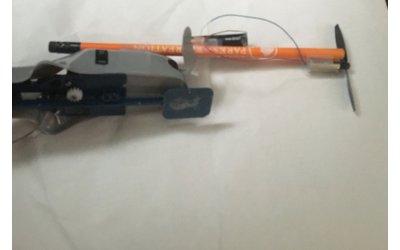For testing this week, I used the Air Swimmer blimp and made different modifications to it. My end goal was to determine whether propellers or using a flapping motion was a more effective way of providing thrust for our balloon.
First, I did some basic flight tests to see how well it moved around the room. I found that the flapping motion was pretty effective, but it was also somewhat slow.
After the initial tests, I worked on implementing a propeller system and adding it to the gondola of the Air Swimmer blimp. Below is the DIY implementation I ended up coming up with.
DIY Propeller:

It uses a AAA battery and the motor mounted to a pencil with tape. I mounted the system to the center gondola of my design. I stripped the wires and bent them such that when I put them in the right position, the motor would turn on.
I found that this propeller design was a decent amount faster than the flapping, (17 seconds across my room in comparison to 10). However, I had no control of the blimp’s direction.
Using flapping motion for propulsion:
Using propeller for propulsion:
Seeing as I wanted to be able to control the blimp better, I tried using the motor and propeller at the same time. I found that this was the best for both speed and control. I could turn the blimp surprisingly well, and the blimp also was much faster than the flapping motion alone. I actually found that the control was better because I could turn the blimp without the extra motions of having to flap for forward propulsion.
Both propellers and flapping:
Overall, I think this set of experimentation was quite successful and if possible, a flapping and propeller mechanism will be the most useful for our project.